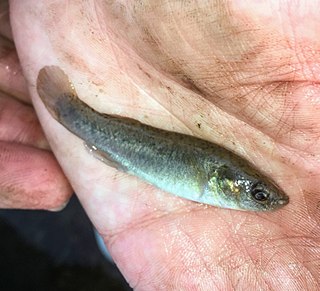
Fundulus is a genus of ray-finned fishes in the superfamily Funduloidea, family Fundulidae. It belongs to the order of toothcarps (Cyprinodontiformes), and therein the large suborder Cyprinodontoidei. Most of its closest living relatives are egg-laying, with the notable exception of the splitfin livebearers (Goodeidae).

Fundulidae is the family of topminnows and North American killifishes.

The blackstripe topminnow, Fundulus notatus, is a small freshwater fish in the family Fundulidae, found in central North America.
The Barrens topminnow is an endangered species of freshwater fish in the family Fundulidae. There are many potential causes of decline of this species including the invasive western mosquitofish that will replace native species on a population level, wading piscivorous birds that prey on adults, and the overall restricted distribution of the species. Managing for this species is vital for its success, but to do so there must be an understanding of the species' characteristics. It is endemic to a small portion of Tennessee in the Elk River and West Hickory Creek in the Cumberland River drainage. The life span of F. julisia is very short, living up to only 3 years. In many cases the majority of the population does not even reach that age. Most adult males are eaten by birds because of their bright coloration during breeding season. Current management plans are in place for the improvement of the species such as captive breeding and reintroduction, and also private management of streams and land. Yet, more can be done to aid them in their survival efforts. Buffer zones around streams can be created to promote the health of the stream and close observation of the introduced populations needs to be a priority. With only three small original populations left in the wild it is important that species survive in captivity, but more so in its natural environment.

The Gila topminnow or charalito is a species of fish in the family Poeciliidae. It is found in Mexico and the United States.

The saltmarsh topminnow is a species of killifish for the family Fundulidae. It occurs in the coastal wetlands of the Gulf of Mexico in the United States.

The golden topminnow is a fish of the genus Fundulus and is a United States native fish mostly distributed throughout the southeast, ranging from Kentucky and Ohio south into Florida. Although it has such a wide distribution throughout the south, the habitats and micro-habitats that it occupies do not differ much from one area of distribution to others. The golden topminnow is a small surface feeding fish that tends to reproduce late in the spring season and on into the early parts of the summer, and although the fry reach maturity fairly quickly the longevity of the golden topminnow is quite short. Because the golden topminnow is lower in the trophic level and is a small fish, it primarily feeds on small and/or drifting organisms at, or near the surface of, vegetated areas. This particular topminnow is not currently listed as an endangered species, nor does it have any particular type of management plan.

The lined topminnow is a small fish in the genus Fundulus which is found in swamps and backwaters from southern Virginia to Lake Okeechobee.
The stippled studfish is a small freshwater fish which is endemic to the Tallapoosa River system in Georgia and Alabama, USA; and Sofkahatchee Creek in Alabama. It belongs to the genus Fundulus in the killifish and topminnow family, Fundulidae. It has been evaluated by the International Union for Conservation of Nature as "near threatened" and has not been recorded in Georgia since 1990.

The Starhead topminnow is a native United States species that ranges from the Ouachita River drainage in Louisiana, the Big Black river in Mississippi, and extends northward into the Mississippi River and Lake Michigan basins to the southern Michigan and southern Wisconsin areas. The Starhead topminnow is endangered due to the removal of aquatic vegetation and the continued development of land that infringes on its habitat.

The northern studfish is the largest of the killifish and is native to the southcentral United States.
The blackspotted topminnow, Fundulus olivaceus, is a species of fish in the family Fundulidae: the topminnows and North American killifishes. It is native to the south-central United States, where it is known from the drainages of the Mississippi River from Illinois to the Gulf of Mexico and as far west as Galveston Bay.

The southern studfish is a ray-finned fish of the family Fundulidae, the tooth carps, that is native to the southeastern United States.

The plains topminnow is a species of freshwater topminnow found in North America. The fish has a small range within the United States of America which consists of two major populations.

The bayou killifish or bayou topminnow is a topminnow-like fish that thrives primarily in the shallow waters off the shores of the Americas, as well as fresh and brackish waters. Feeding off of small vertebrates and invertebrates, this fish displays reproduction techniques unique to its species.

Fundulus nottii, the bayou topminnow or southern starhead topminnow, is a fish of the family Fundulidae found in the southeastern United States.

The Seminole killifish is a fish of the genus Fundulus, endemic to the U.S. state of Florida.

The banded topminnow is a North American species of temperate freshwater killifish belonging to the genus Fundulus of the family Fundulidae.

The russetfin topminnow is a North American species of temperate freshwater killifish belonging to the genus Fundulus of the family Fundulidae.
















